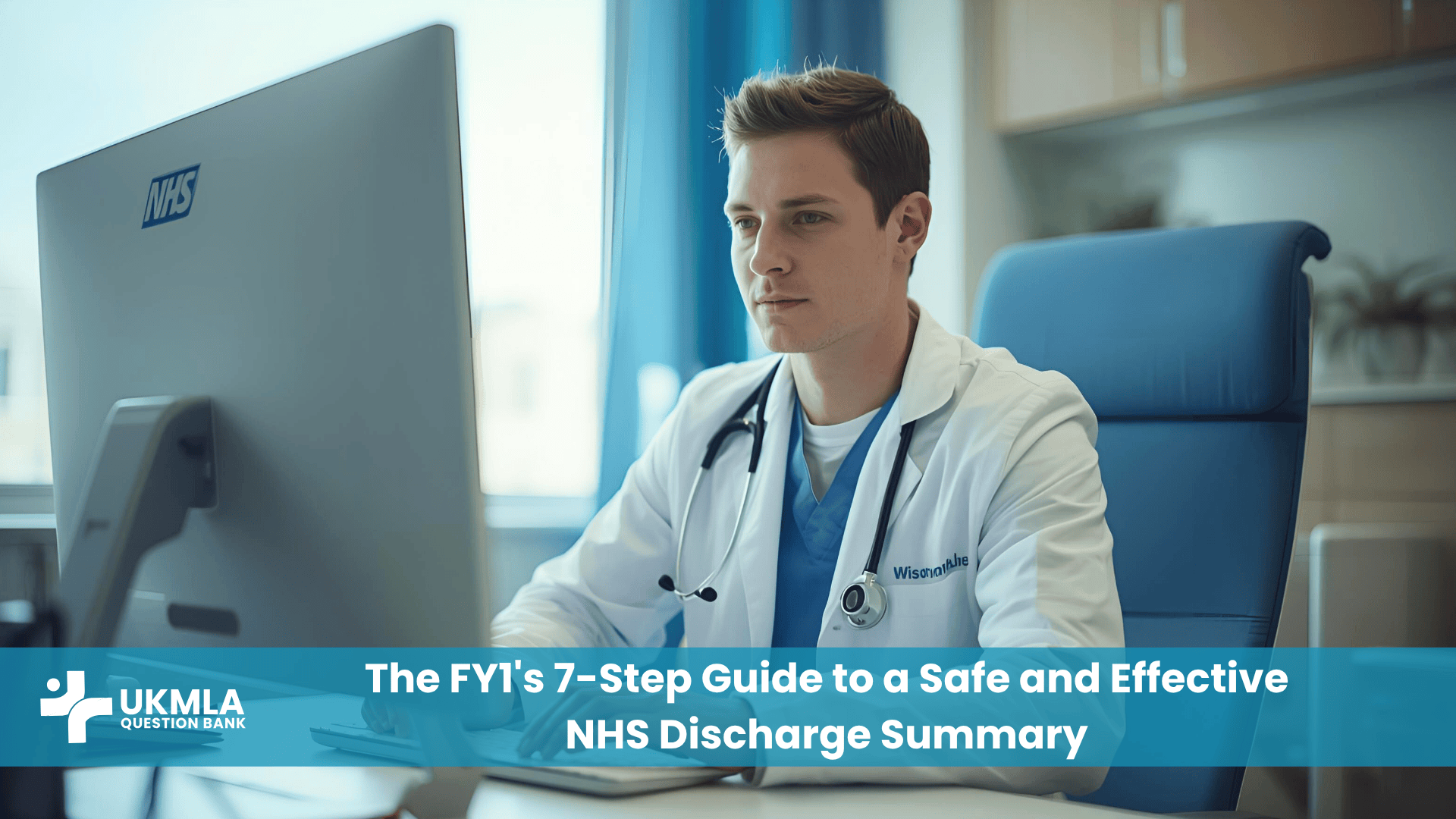Introduction
Addison’s disease is a classic high-yield topic for the UKMLA, yet its vague initial presentation makes it a common diagnostic challenge. If you find the constellation of symptoms confusing, you’re not alone. This guide will simplify the core concepts you need to master for addisons disease ukmla questions, breaking down the pathophysiology, diagnosis, and management into clear, memorable points for your exam.
Table of Contents
ToggleThe Core Problem: Why is Addison’s Disease So Tricky?
The main challenge with Addison’s disease is that its early symptoms are non-specific and can mimic many other common conditions like depression or chronic fatigue syndrome. Understanding the underlying pathology is key to recognizing it.
Primary Adrenal Insufficiency: What It Means
Addison’s disease is the common term for primary adrenal insufficiency. This means the adrenal glands themselves are damaged (most commonly by autoimmune destruction in the UK) and can no longer produce their essential hormones. This is a core topic covered in any good UKMLA endocrinology essentials guide.
The Missing Hormones: Understanding Cortisol & Aldosterone Deficiency
The symptoms are all a direct result of lacking two key hormones:
Cortisol (a glucocorticoid): Lack of cortisol leads to profound fatigue, weight loss, muscle weakness, and low blood sugar (hypoglycaemia).
Aldosterone (a mineralocorticoid): Lack of aldosterone causes the body to lose sodium and retain potassium, leading to low blood pressure (hypotension) and specific electrolyte imbalances.
Spotting the Clues: Key Signs and Symptoms
While initial symptoms are vague, there are classic clues to look for in a UKMLA scenario.
The Classic Sign: Understanding Hyperpigmentation (The ACTH Effect)
When the adrenal glands fail, the pituitary gland tries to stimulate them by releasing large amounts of Adrenocorticotropic Hormone (ACTH). A precursor molecule to ACTH also stimulates melanocytes (melanin-producing cells in the skin). This leads to the hallmark sign of hyperpigmentation, a bronze-like tanning of the skin, especially noticeable in sun-exposed areas, skin creases (palmar creases), and on mucous membranes like the gums.
Vague but Vital: Fatigue, Weight Loss, and Abdominal Pain
Profound fatigue that is out of proportion to the clinical picture is a major feature. Unintentional weight loss, nausea, vomiting, and diffuse abdominal pain are also very common due to cortisol deficiency.
The Telltale Labs: Hyponatremia & Hyperkalemia
Interpreting clinical data is vital for the AKT. Due to the lack of aldosterone, the kidneys excrete sodium and retain potassium. This leads to the classic electrolyte picture you must remember. For more practice on this skill, review how to approach interpreting clinical data for the UKMLA AKT.
Clinical Pearl: A patient presenting with unexplained low blood pressure, low sodium, and high potassium should make you think of Addison’s disease immediately.
The Definitive Diagnosis: Mastering the Short Synacthen Test
Once you suspect Addison’s disease, you need to know how to confirm it.
How the ACTH Stimulation Test Works: A Step-by-Step
The definitive diagnostic test is the short synacthen test (or ACTH stimulation test).
A baseline blood sample is taken to measure the patient’s current cortisol level.
The patient is given an injection of Synacthen (a synthetic version of ACTH).
Blood is taken again at 30 and/or 60 minutes to measure the cortisol response.
Interpreting the Results: What a “Failed” Cortisol Response Looks Like
In a healthy person, the synthetic ACTH will cause a sharp rise in blood cortisol levels. In a patient with Addison’s disease, the adrenal glands are damaged and cannot respond. Therefore, a failed or minimal rise in cortisol after the ACTH injection confirms the diagnosis of primary adrenal insufficiency.
Table 1: Classic Biochemical Profile in Addison’s Disease
| Parameter | Level | Reason |
|---|---|---|
| Sodium (Na+) | Low | Aldosterone deficiency (salt-wasting) |
| Potassium (K+) | High | Aldosterone deficiency (K+ retention) |
| Cortisol | Low | Adrenal gland failure |
| ACTH | High | Pituitary trying to compensate |
Emergency Management of addisons disease ukmla
Knowing how to manage an Addisonian crisis is a critical piece of knowledge, as it’s a true medical emergency. For more on this, consult the UKMLA emergency medicine essentials and authoritative sources like the NIDDK.
Recognising an Addisonian Crisis
This is a life-threatening emergency characterized by circulatory collapse. It’s often triggered by infection, trauma, or surgery in a patient with known (or undiagnosed) Addison’s. Key features are:
Severe hypotension (shock)
Hypoglycaemia
Vomiting and abdominal pain
Fever
Confusion or collapse
Immediate Steps: IV Hydrocortisone, Fluids, and Glucose
Do not delay treatment while waiting for test results. If you suspect an Addisonian crisis, immediate management is key:
Give IV Hydrocortisone 100mg STAT. This is the single most important step.
Start IV fluid resuscitation with normal saline to correct the hypotension.
Correct hypoglycaemia with intravenous dextrose if necessary.
Frequently Asked Questions (FAQ) about Addisons Disease for UKMLA
In secondary adrenal insufficiency, the pituitary gland is the problem and doesn’t produce ACTH. With low ACTH, there is no stimulation of melanocytes, so no hyperpigmentation occurs. This is a key differentiating feature.
Think of what aldosterone does: it saves sodium and excretes potassium. In Addison’s, you lack aldosterone, so you do the opposite: you lose sodium (hyponatremia) and retain potassium (hyperkalemia).
Lifelong hormone replacement with oral hydrocortisone (to replace cortisol) and fludrocortisone (to replace aldosterone).
During illness or stress, the body naturally produces more cortisol. Patients on replacement therapy must mimic this by increasing their hydrocortisone dose (“sick day rules”) to prevent an Addisonian crisis.
No, it is a very safe and standard diagnostic test. Synacthen is a synthetic hormone that is quickly metabolized.
Autoimmune adrenalitis is the cause in over 80% of cases in the developed world. Worldwide, tuberculosis is also a major cause.
Yes, with proper medication and education about sick day rules and emergency hydrocortisone injections, patients can live full and normal lives.
They should wear a medical alert bracelet and always carry an emergency hydrocortisone injection kit.
It can be seen on the gums (mucous membranes), in scars that form after the disease onset (as they heal with more pigment), and on the tongue.
You must ask about their medication compliance, if they have followed “sick day rules,” and if they have any signs of infection or other stressors that could trigger a crisis.
Conclusion
Addison’s disease is a perfect topic for the UKMLA because it tests your ability to connect physiology with clinical signs, interpret lab data, and act decisively in an emergency. By remembering the vague initial presentation, the classic clue of hyperpigmentation, the definitive synacthen test, and the critical steps for managing a crisis, you can confidently tackle any question on addisons disease ukmla that comes your way.




